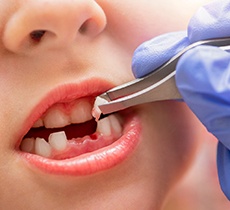9:00am - 5:00pm
10:00am - 6:00pm
10:00am - 4:00pm
10:00am - 4:00pm
By Appointment Only
By Appointment Only
Tooth Extractions – Garland, TX
Saving Young Smiles for Better Oral Health

A child’s smile deserves exceptional oral healthcare to ensure a brighter future. This is why regular dental checkups and teeth cleanings are essential. However, when an accident occurs or severe decay is left untreated, it can result in a more complex treatment that requires the removal of one or more teeth. Tooth extractions are not likely to be our first option, but Dr. Lily and her team will evaluate the situation to determine if it is the best course of action to prevent further damage to the rest of your child’s smile. Call us today to learn more about this important method of treatment.
Reasons Why Tooth Extractions Are Necessary

If you’re worried that we will just simply recommend tooth extraction no matter the situation, you can rest easy knowing that we do not take this decision lightly. Instead, we survey the severity of the damage or decay and base our choice on how it might impact the rest of your child’s smile if left in place.
Should we discover that there are signs of any of the following, we will recommend tooth removal for the safety and future of your child’s oral health:
- They have extensive decay that is putting nearby healthy teeth at risk.
- They have sustained significant damage to a particular tooth that cannot be saved with root canal treatment or a dental crown.
- They have a baby tooth that will not fall out on its own but needs to be removed for the permanent one to push through.
- They require orthodontics to address overcrowding but need ample space to allow the teeth to shift.
The Process of Removing a Tooth

Dr. Lily and her team will look to see what kind of tooth removal procedure is necessary. In most cases, children have partially erupted teeth, which means they can typically be removed without surgical intervention.
We’ll administer local anesthesia to numb their mouth before using age-appropriate dental instruments to elevate the tooth from the socket and gently move it back and forth. This continuous motion will encourage the tooth to detach from the underlying ligaments.
If for some reason the tooth that must be removed is beneath the gumline (impacted), surgical extraction will be required. This involves opening the gum tissue to access the tooth beneath the gums. To avoid damaging the bone, we will likely have it removed in pieces for a smoother and less stressful procedure.
Tooth Extraction Aftercare

Once you bring your child home to recover, it’s important that you make sure all necessary instructions are followed. These include:
- Helping your child get ample rest once they return home. It’s best if they lay on an elevated pillow so that it prevents blood from rushing to their head.
- Keeping clean gauze on the wound to minimize bleeding, which should reduce significantly in a short amount of time.
- Keeping them from spitting, sucking, or using a straw for the first 24 hours, as this can cause the blood clot to dislodge, resulting in a painful dry socket.
- Using an over-the-counter pain reliever to alleviate discomfort. A cold compress can also be used for the same reason in addition to reducing swelling.
- Limiting what they eat, having them only consume liquids for the first few days. They can then begin to incorporate soft foods that do not require biting down or chewing.
Tooth Extraction FAQs
Does Getting a Tooth Extracted Hurt?
It’s natural to be worried that your child will feel discomfort during a tooth extraction procedure; however, we are here to ease your concerns. Not only will your little one receive local anesthesia to numb the areas of their mouth, but, if necessary, they’ll also be provided with sedation dentistry to calm their nerves. The removal of the tooth will not cause them to feel any pain. Once the procedure is over, though, they will likely experience some soreness in the following days.
The good news is that over-the-counter pain relievers can help minimize discomfort and keep them comfortable during the healing phase of treatment.
How Should I Prepare My Child for My Tooth Extraction?
Before your child comes in for their tooth extraction, you’ll want to make sure that you ask any questions beforehand. If your child is old enough, encourage them to do the same.
In the days leading up to the appointment, as well as the day of, make sure that they:
- Follow our instructions as to when they should stop eating and drinking.
- Have someone who can take them, stay, and bring them home after their appointment.
- Ensure they wear comfortable clothes to the appointment. They can even bring a stuffed animal or something that brings them comfort.
- Pick up any prescriptions before the appointment so that they are ready to take when necessary.
Can We Leave the Space Empty After a Tooth Extraction?
Typically, if it is a baby tooth that is being extracted, there will be no need to create a replacement, as the permanent tooth will eventually erupt. If for some reason a space maintainer is required, we will put one in place.
If the tooth being removed is a permanent one, we will need to make sure that existing healthy teeth do not begin to shift out of alignment. To prevent this, we will need to craft a tooth replacement solution that might look something like a dental bridge or partial denture. These prosthetics will help to rebuild your child’s smile so that it functions normally and looks natural.
What Risks Are Involved with Tooth Extractions?
One of the primary concerns of parents and patients is whether there are any risks associated with tooth extractions. This is normal. Fortunately, these procedures are extremely safe, but as it is with any kind of dental surgery, there are a few risks involved.
The most common one is infection. Another is a dry socket, which can occur if the blood clot that forms accidentally becomes dislodged. This can lead to much pain and prolonged recovery.
To avoid a dry socket, you can expect that we will provide a list of aftercare instructions so that your child understands how to avoid this problem and what symptoms to watch out for that might indicate a dry socket has occurred.

